This offseason we’ll be breaking down the performance of each unit – passing and rushing offense and defense – with a look ahead to 2021 and what this means for the Irish. Next is the Notre Dame passing game, which overachieved in Ian Book’s final year thanks to a mini-leap at QB, a veteran receiving group stepping up after injuries sapped some upside, and an incredible tight end room duo. Yet again the Irish will need to find answers at receiver as explosive players return from injury and blue chips enter the mix. But this year they’ll need to do it with a new signal-caller – what can the offense look like with Jack Coan, Drew Pyne, or Tyler Buchner at QB?
Previous entries:
Passing Efficiency
When Ian Book emerged as a high-level QB in relief of Brandon Wimbush in 2018, engineering a highly efficient passing attack was his hallmark. Early on the deep ball was his Achilles heel, but Book’s accuracy and decision-making on medium and short throws were the bedrock of the offense in an undefeated regular season.

The first half of 2019 saw a significant step back in consistency (both in passing efficiency and yards per attempt) before Book righted the ship down the stretch. And while 2020 didn’t bring a dramatic upswing in the passing game’s statistics, considering the weapons on hand it was a terrific return to form. “Game-management” is usually reserved as a backhanded compliment for quarterbacks, but Book appeared fully in control of the offense and flow of the game – determining where to take risks, when to use his legs, and avoiding costly mistakes.
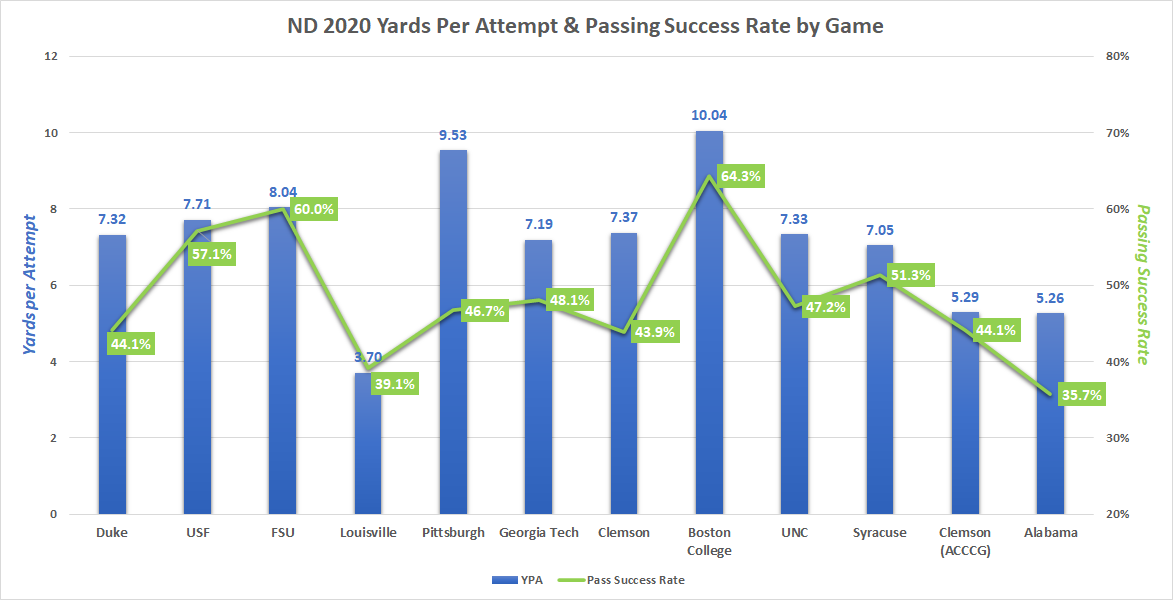
Book had just one regular-season game with below-average passing success or less than seven yards per pass attempt, the gusty and weird Louisville afternoon. The stretch that followed that near-upset, from Pitt to Syracuse, will go down as Book’s magnum opus. The Clemson and UNC games saw a senior in complete control of the offense, coming up clutch in key situations and improvising to create things out of nothing on massive stages. The magic ran out down the stretch in the rematch against Brent Venables and in the playoff, but it’s hard to place too much blame on Book for those shortcomings.

Last fall also saw the return of clutch 3rd down performances from Book. The 2019 offense struggled mightily converting these both in short and long distances to gain; in 2020 the Irish made major gains (over 10% better) in both categories. In fact, Notre Dame’s passing EPA on third downs ranked extremely well compared to the best passing offenses in the game – better than Ohio State, Clemson, and Alabama. Notre Dame was less aggressive and productive than these passing offenses on early downs, but this 3rd down efficiency through the air was a big part of Tommy Rees secret sauce.
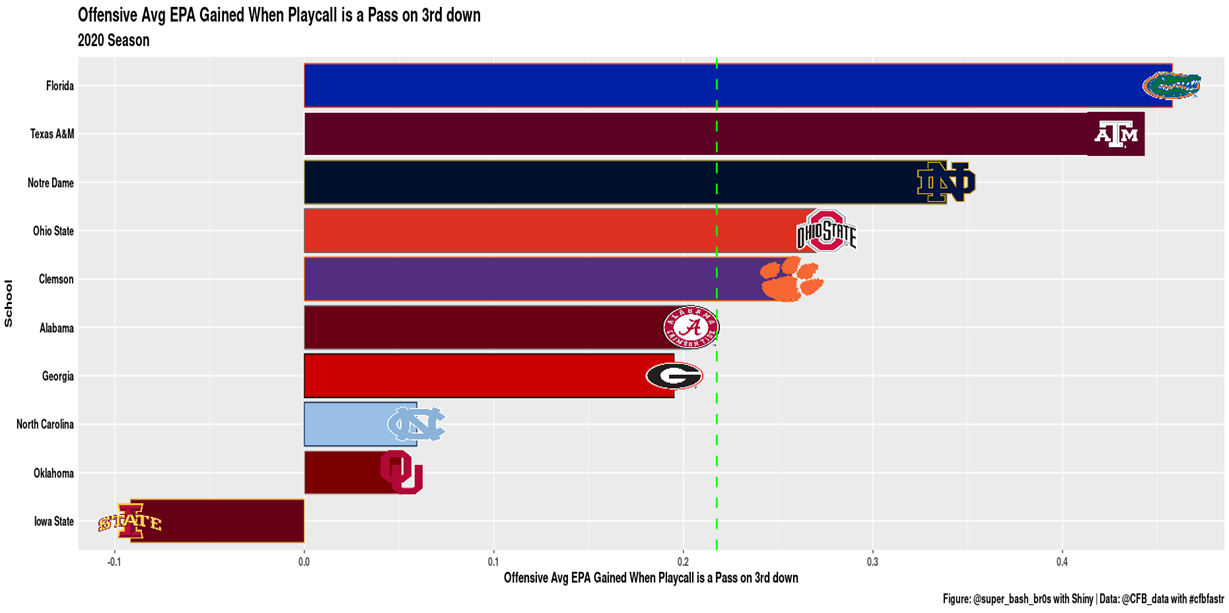
Passing Explosiveness
If there’s one category that’s generated the most angst and discussion this offseason, it’s big plays through the air. Could the Irish have manufactured more explosive offense? If we gave Tommy Rees truth serum, I think he would probably admit he wished Book would have taken a few more chances downfield. But, at the same time, that was clearly out of Book’s comfort zone to attempt to throw guys open, and he was working with receivers not capable of consistent downfield separation.
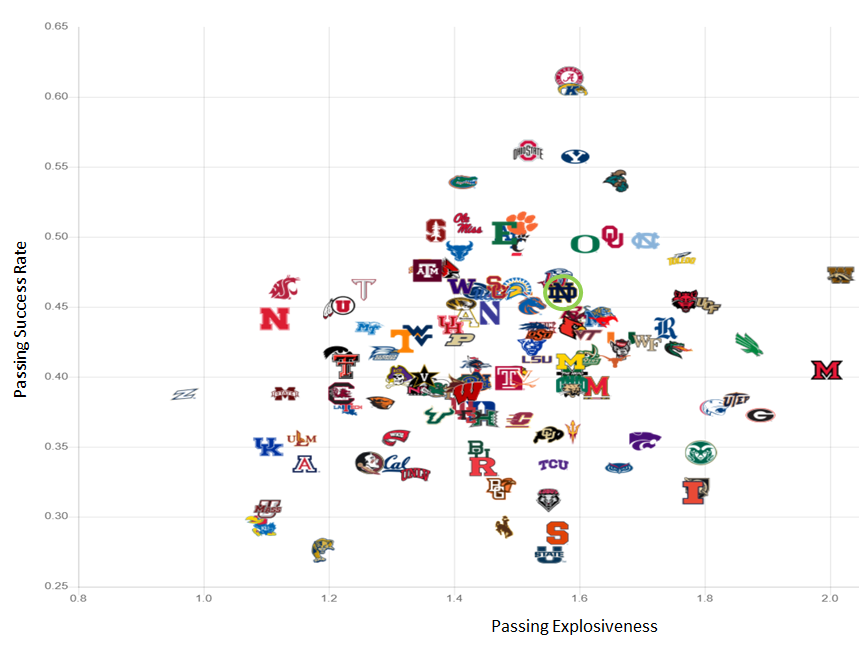
If you gave Irish fans a blank chart and asked them to chart which teams Notre Dame fit next to for passing explosiveness, how far off would they be?
Rees could have called more shot plays or pushed harder for Book to toss up some 50/50 balls to his large receivers. But there are trade-offs to those high-upside / low probability throws. A massive reason for Notre Dame’s offensive success was 3rd down performance, primarily through the air. Scheming up more explosive plays would be a conscious choice to do more of what Notre Dame was less equipped to do, at the presumed cost of the efficiency that kept the offense humming.
Book and the offense were primarily able to convert so many chances by staying out of 3rd and long situations, as seen above. The offense averaged 6.47 yards to gain on 3rd downs, 9th easiest among P5 teams last season. Converting third and mediums and avoiding turnovers doesn’t make the most exciting highlight reels, but it led to effective offense. The offense still ranked 19th in FBS in offensive yards per play and 13th in the rate of offensive drives gaining at least four yards per play. That consistency leads to fewer three and outs and easy scoring chances – opponent’s average starting field position was their own 26-yard line, 10th best for Clark Lea’s unit, and crucial for a bend but don’t break scheme.
Receiving Production by Receiver
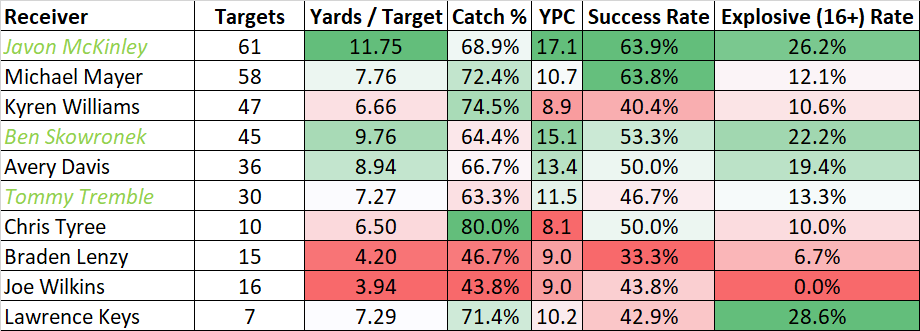
Lost in the complaints about wide receiver recruiting and hundreds of message board posts about Jordan Johnson was that Javon McKinley had a quietly outstanding season. His late-career breakout saw him post outstanding efficiency and explosiveness numbers while also blocking well. In fact, McKinley’s production per target stands out as better than even Boykin and Claypool’s seasons as WR1.This doesn’t mean McKinley is a better receiver– he benefitted from the best version of Ian Book, where Claypool received a lot of targets that were lower quality. But it puts into context just how productive the offense was last season going in his direction.
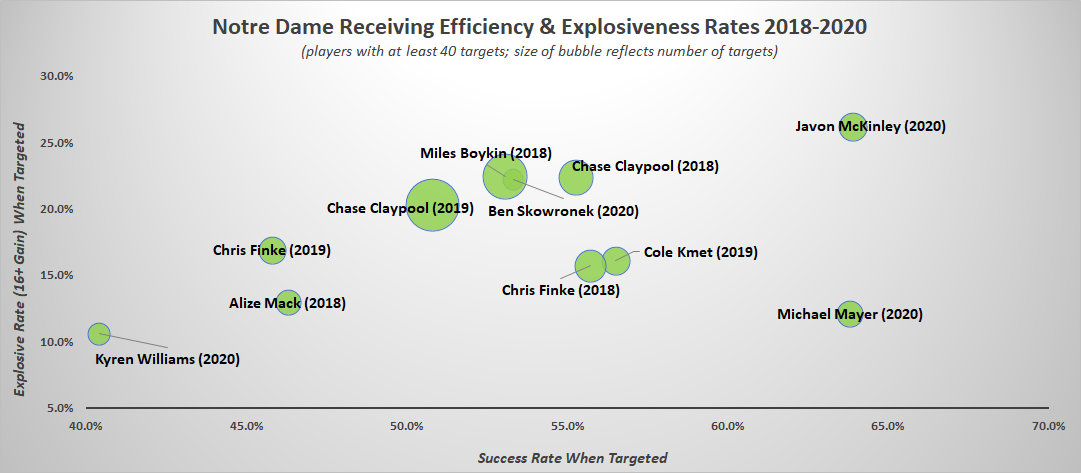
The other standout was a true freshman that by the end of the year was arguably the most dangerous receiving threat. Michael Mayer quickly emerged as a go-to receiver as a true freshman and was also an extremely efficient outlet for Book. If the Irish can utilize his ability on medium and longer passes next season, an All-American caliber performance is easily within reach.
Kyren Williams suffers in individual passing metrics with lots of passes thrown to him as a safety valve or right at the line of scrimmage. By all accounts, he can be a dynamic pass-catcher out of the backfield, but last season there were only inconsistent flashes. Avery Davis had an unexpectedly terrific start to the season, grabbing the slot role from Lawrence Keys and carving up Clemson and Boston College. He faded down the stretch, though, with just six catches and 45 receiving yards in the final four games. He’ll have to hold off Keys (again) and Lorenzo Styles for snaps but provides a stable floor of performance for a unit in desperate need of proven commodities.
Notably absent is any contribution from several high-upside options, highlighted by the injuries to Kevin Austin and Braden Lenzy. It’s been a long time since the Irish have had multiple proven options returning at wide receiver. For the most part, they’ve managed to survive with players emerging late in their careers like Miles Boykin and Javon McKinley. Joe Wilkins and Lawrence Keys could fit this mold, although their opportunity feels more limited to a complementary role versus a breakout.
Notre Dame hasn’t intentionally relied on this veteran-heavy strategy though, it’s just been more productive than the lottery tickets of finding out which young receivers will be ready. Lenzy appeared to be a star in the making and essentially lost a season to injury. Jordan Johnson and Xavier Watts weren’t ready, and the staff whiffed on the recruiting class before. With injuries sapping upside, the Irish were fortunate to have veteran depth like McKinley, Davis, and Skowronek as a grad transfer to provide strong blocking options Book could trust to be in the right spots.
2021 Outlook
Despite a nice spring by Drew Pyne and strong Blue-Gold game effort by Tyler Buchner, a lot of 2021 hinges on Jack Coan. In many fans rush to anoint Buchner to next hope for elite QB play, Coan has been underrated and brings a high floor and wealth of experience from a strong 2019 season. That fall, Coan’s numbers compared favorably with the guy he’s replacing, edging ’19 Book in passer rating (151.8 – 149.1), yards per attempt (8.0 – 7.6), and completion rate (69.6% – 60.2%).
Coan also finished 9th in ESPN’s QBR and finished the season playing three straight games against top 10 teams, including the Big Ten title game and the Rose Bowl. He obviously shouldered a much lighter burden than Book, and averaged only 24 attempts per game. But Coan can be extremely accurate in some different areas of the field, and may throw with a little more anticipation.
From PFF’s review of 2019: “There are several distinct areas where Coan had success but there were 132 quarterbacks to attempt at least 10 passes outside the numbers and 20 yards downfield. Coan graded out with the sixth-highest passing grade, connecting on six big-time throws, four touchdowns and 243 yards on such attempts and five of those big-time throws were targeted to Quintez Cephus.” Some ND fans have discussed Coan as a seatwarmer, but PFF graded him above Kellen Mond, Shea Patterson, and Bryce Perkins in his last season starting. Book excelled a turnover avoidance, but may have left a few big plays on the table taking the safe route. Can Coan be a guy who puts more of those high-risk / high-reward balls up for grabs?
The Irish finished last season 25th in Passing EPA / play and 18th in Passing Success Rate. Returning passing production and receiving production are the strongest predictors of success on offense, so losing Ian Book and the McKinley/Skowronek/Tremble trio hurts. Yet Coan provides stability at QB, and it’s hard to envision the receiving group coming up empty again when at a minimum Mayer should wreak havoc and open things up.
The floor appears stable but quality depth is again a question mark, especially with Jordan Johnson’s transfer. Given Austin and Lenzy’s injury histories, it’s concerning that there could be a repeat of 2020. It would be painful if again the Irish are forced to choose between less dynamic veterans like Davis, Wilkins, and Keys or young talent that may not be fully formed (Styles, Watts, Colzie).
Pass blocking is also a question mark with the offensive line overhaul. While the OL took a big step backward in run blocking in the last big transition year, 2018, they compensated with solid pass protection. That unit ranked 38th in sack rate, highlighted by 16th in protecting Ian Book on passing downs. They continued to improve in 2019 (16th overall sack rate / 9th on passing downs) but then took a surprising step back last season (82nd / 61st).
The quarterback also plays a big role in sack rates, and Coan’s style in the pocket may lend itself to improvement even with a drop-off in pass blocking. Running and scrambling QBs tend to have higher sack rates, even with good lines – for example, Ohio State was 103rd in sack rate with Justin Fields last year. Coan is much more of a rhythm passer (or was at Wisconsin), but is also more likely to hang in the pocket longer. On paper this doesn’t look like an offense that can sustain a lot of negative plays, so figuring out a way to back to solid if not spectuacular sack prevention feels like a good goal.
Irish Sports Daily’s Jamie Uyeyama also found some data to support this idea in his always-excellent Six Thoughts:
“What won’t be missed [about Book] was his tendency to drift into pressure. It was a huge problem in 2019 where PFF charted that 40.8% of the pressure he faced were plays that he was at least partially responsible for. That was first in the country (or last if you want to take it that way). Book improved significantly to 22.8% in his last season, but that’s still not ideal.
Jack Coan, who is certainly not Houdini in the pocket, was only partially responsible for 10.8% of pressure against him. He was near the bottom (or the top) in that category. Graham Mertz took over at quarterback for Wisconsin last season and was one of the worst at moving into pressure at 32.4%.”
Like the rushing offense, the passing game seems more likely to regress than sustain the same production or improve in 2021. Too many critical position groups have too many question marks – QB should be worse a degree or worst-case a few degrees. The offensive line seems like a lock to decline in a rebuilding year. Wide receiver is the biggest reason for hope if the long-awaited Kevin Austin breakout finally arrives, if Lenzy can recapture his late 2020 health and form, or young talent like Xavier Watts, Lorenzo Styles, or Deion Colzie can make an immediate impact. But even that unit, while laden with upside, has a converted QB-CB-RB as its most proven returning option.
As with the running offense, a top-30 to 40 pass game is a reachable goal. These are first-world problems; a program even like Virginia Tech would love to have a QB with Coan’s production and experience, a host of OL blue-chippers even as young as they may be, and a wide receiver room with tons of untapped potential. But with a lot of questions about the offense as a whole, it’s hard to know what the offense will be able to reliably hang their hat on. There’s plenty of upside and enough talent that scoring on any opponent on the schedule doesn’t seem too daunting. But to compete nationally, it’s going to take a great scheme, taking advantage of opponent weaknesses, and the young talent developing with a vengeance.




I keep seeing people say things like “Book was in complete control of the offense” in that first Clemson game. It’s a little frustrating to read things like that when the offense scored its first TD 23 seconds into the game (with an 8 yard completion being the only pass) and didn’t score another TD until 22 seconds left in the 4th quarter. If that is what it looks like when the QB is in “complete control” at ND, then ND needs a major overhaul to its offense/playmakers to win a National Championship.
I know Coan was similarly an efficiency guy at Wisconsin, but I really hope Rees pushes him to be more aggressive, especially if some of the more athletic playmakers (Austin, Lenzy) are healthy this year.
Book posted the highest PFF rating for a QB vs Clemson since 2014. The offense created 9 scoring chances. I think it’s pretty well established the skill position weapons weren’t the most dynamic, so that didn’t mean automatic TDs. Maybe it’s a difference in interpretation, but to me a QB being in control is about maximizing his skill set and setting his teammates up for success, and was intentional versus something like being dominant or dictating the game. I know the last two games left a bad taste in peoples mouths in terms of the gap vs elite pass offenses but being frustrated with praise for Books work in that game is a weird place to be.
Sorry, by “frustrating to read that” didn’t mean “you’re wrong.” It meant “damn, if our QB ran the offense as well as he possibly could and we still couldn’t score touchdowns for 58 minutes, ND has a lot of work left to do.”
I keep thinking back to that game and sort of hoping that Book left a lot of plays out on the field that I’m not remembering and that’s the reason we couldn’t score TDs; but then you (and many, many others) have pointed out he did basically everything asked of him, and we still struggled to get into the end zone. So not frustrated with you or your analysis; frustrated that there’s still plenty of work to be done on the offensive side of the ball.
All good, and you are right that it’s frustrating that the recruiting talent and gaps haven’t enabled great OLs (20, 17) to match with best QB and WR talent.
You can’t remember the points left on the field that game ? Book’s fumble, Meyer’s couple of mistakes. IIRC there were about 13-15 pts.
Yeah, good points. I rewatched the game recently and agree with Michael’s analysis that Book was in great control of the offense. The problem, as you point out, was a big problem all year with struggles in the red zone and failing to finish.
Book was making decisive reads and letting it rip with confidence down the field. It is very frustrating in a way, wondering why he didn’t play like that all the time, especially as he got older and more experienced. But he didn’t always look comfortable on certain games and days.
Also Jay Brunelle is transferring lol. Xavier Watts is the only receiver remaining from a 2 year recruiting stretch. Del Alexander is Brian Kelly’s new BVG.
Just posed about that at the same time you did. I suppose the only silver lining is that it allows us to take one more WR in the 2022 class. We needed to take probably 4 and now we will probably be looking for 5 and won’t have to hold off accepting a commitment from a guy b/c we are waiting on a higher priority WR to decide. There is room in the class.
I’m trying to be glass half full here…
The glass half-full part of it is that if Brunelle was ever a contributor, we were in big trouble anyway. He was the lowest rated WR recruit under BK by a good margin (unless you count Joe Wilkins, who was still 50 spots higher nationally as a DB). He was ranked 150 spots lower than Daniel Smith, the 2nd lowest pure WR recruit under BK.
I would say Brunelle was arguably the second least likely offensive recruit to contribute in the past 10 years, in front of only RPIII.
Agreed, if Brunelle doesn’t think he can see playing time, with the two deep we’re looking at right now, it says all you need to know about how the coaches feel about his abilities. He’s a local kid and I’ve been pulling for him but, obviously he wasn’t going to help much. WR recruiting is quite troubling.
Del Alexander has been that the entire time. Remember the Freddie Canteen experiment?
Passing offense for the future took a hit today. Jay Brunelle enters the transfer portal. I’m not saying he was a star in the making but the depth from the 2019 and 2020 classes is completely gone. We better hope X Watts, Syles, and the other freshmen are gonna be legit b/c we will have only 9 scholarship WR come the fall and only 4 of them are underclassmen.
If a couple of the seniors don’t come back in 2022 we could be in big trouble at WR.
They’ll be fine — transfer portal patchwork incoming. They won’t be tremendous, but it will be OK. Brunelle was a fairly low three star who wasn’t going to see the field this year, or next year either. It’s a hit to having a warm body around, but not much else IMO. In the bigger scheme of things (like Jordan Johnson failing) yeah it’s a problem that will hurt, but I’m not too too worked up over this one.
Eh, Brunelle was preferred walk on territory. Best case scenario he’s Chris Finke, so a decent WR3 outlet by his fifth year. The fact that we tried to settle for him in the first place is the problem.
Again, I was not trying to imply that we were losing a potential future star. I was pointing out that we have had 4 WR transfer from the program in the past few months and now have 1 WR left on the roster from 2 recruiting cycles.
2022 would be Brunelle’s third year in the program and it would be reasonable at that point to expect him to be an emergency 6th or 7th WR on the roster and provide a reasonable amount of depth on the roster. Now that 6th or 7th guy has to either be a freshman or a transfer (and transfers are far from a sure thing in terms of acceptance into ND and their actual value, i.e. Freddie Canteen and Cam Smith).
Folks wanted young players to play, right? Good news – young WR’s are going to have to play soon!
A Canteen or Smith level transfer would be fine as a 6th/7th emergency option that’s never going to see the field anyways. Last year Notre Dame’s 7th leading receiver had 1 catch (Kevin Austin) and barely played. Ideally it’s more a Skowronek level player, too..
It’s a bit unsettling to see so many from the same position leave, but oh well, so it goes. Johnson apparently wasn’t fitting in and Brunnelle, Rahman, whoever else left were all low rated players who probably aren’t going to be very high level players or ever see the two-deep anyways.
Yeah. His transfer isn’t the problem, but it does highlight the problem. Not much talent (numbers or skill). I’d just as soon give his practice reps to a mid 3 star true freshman with some potential.
Or better yet, sign 5 top 150 LBs and move one/two to WR. They’d be in the 2 deep as freshmen. I’d rather have Sebastian Cheeks on the team than Jay Brunelle, irregahdless of the depth at each of their positions.
I’d just as soon see 3 more not-great WR’s transfer immediately so they have no choice but to play Kyle Hamilton on offense 🙂
#Heismilton
This is an example where the advanced stats seem wonky if you’re recalling watching the games. So much of the passing offense was Book scrambling around and making time because the receivers couldn’t create separation on their actual routes until they went into the scramble drill. Basically it was either Book hits Mayer on a drag route (because for some reason he couldn’t throw over the middle) or jukes defenders for five seconds until McKinley can get open. This was not a healthy passing offense and it’s sort of amazing it worked as well as it did.
I don’t know whether the problem was Book, his receivers, the scheme, the reads (which I suppose is also Book) or not, but the offense just never has felt explosive with him. That said, there were plenty of explosive plays. Rees is right about the fact that well executed short pass that turns into a 60 yard play or a 60 yard bomb basically get the same result is true.
When he was the QB, Rees best pass was the TE over the middle on a ‘go’ type route. I don’t think Book liked that route all that much. We saw more of those passes with Coan, pyne and Buchner in the spring game than we did from Book in 2020. The intermediate middle was the part of the game I felt Book lacked.
All that said, he won. When Rees becomes HC, perhaps Book will be the QB coach. LOL. (maybe not).
As for next year, there is some talent at WR, but it is incredibly injury prone (Lenzy, Keys, Austin) or really young (Watts, Styles, etc.) I think we have seen peak Davis, which isn’t bad, but it is a good 4th WR peak on a championship team. Wilkins is likely not going to emerge into the receiver McKinley or Boykin did, and being honest catching a late developing senior receiver is a bit like lightning in a bottle. Three in a row would be a lot.
Based on the spring game, it seems all of the QBs have the most trust in Keys, based solely on targets. The play is called, but the QB throws to the person he is most comfortable with in the reads. That was why the departed Johnson got no targets. It was clear that the QBs didn’t trust him. Keys has to knock someone off the field. Is it Davis? Lenzy? Austin? Those 4 won’t throw any fear into the hearts of DBs anywhere. Perhaps a healthy Austin would, but will he be healthy and can he stay healthy?
I think Coan is more mobile than people think, but he is not a runner like Book. I imagine we will count on one hand the designed QB run plays. However, I think he will pick up a few first downs with his feet on a scramble. IF the receivers run their routes and gain some separation, which they typically did not for Book, or not enough, then we will be fine. If not, it will be a long year.
All that said, he won. When Rees becomes HC, perhaps Book will be the QB coach. LOL. (maybe not).
2025?